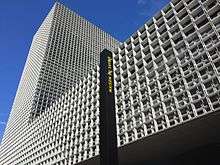Belval, Luxembourg
Belval is a quarter and neighbourhood in the west of Esch-sur-Alzette, in south-western Luxembourg. Belval is the site of the large steelworks that dominate the city. Due to the dominance of the steelworks, Belval suffered from the abandonment of steel production in Luxembourg, and is undergoing an extensive regeneration programme to help diversify beyond steel production. The redevelopment plan, costed at €450m, will turn the brownfield site into a large scientific and cultural centre, including the science faculty of the University of Luxembourg.[1] It is the location of the Rockhal, Luxembourg's largest music venue, which opened in 2005.
Belval is served by two railway stations operated by Chemins de Fer Luxembourgeois: Belval-Université and Belval-Rédange.
Site History
Content in this edit is translated from the existing French Wikipedia article at Esch-Belval; see its history for attribution.
The siderurgical era
Between 1909 and 1912, the company Gelsenkirchener Bergwerks A.G. built a brand new steelworks at Esch-sur-Alzette: the factory Adolf-Emil.
In 1911, the company ARBED (Aciéries Réunies de Burbach-Eich-Dudelange) was created by the merger and acquisition of the 3 largest steelworks in Luxembourg.
In 1994, ARBED decided to change its type of steel production for long products (such as sheet piling) at its sites in Luxembourg. The steel production moved from produced from iron ore with blast furnaces to electric arc furnaces using recycled steel.
With the closing of the last blast furnace in Esch-Belval in July 1997, 120 hectares (approximatively 300 acres) were available for a reconversion process, offering a place with a high economic development for the country and the whole southern region.
The Belval project
In 2001, an international urban planning contest was set up to take the best decisions about the Belval project.
After a detailed study of the projects, focused on the profitability, duration and site preparation criteria, a dialogue committee, supervised by the Ministry of the Interior, decided on 8 March 2002 to pursue the planning on the basis of the project from the Jo Coenen & Co architects and urbanists of Maastricht.
Across the different districts, the project will be able to accommodate more than 5,000 inhabitants and more than 20,000 daily users. The new urban setting extends over a developed surface of almost 1.3 million m², on 69 hectares for building. An important proportion (30 percent of the surfaces) is saved for green and public spaces.
The conditions of its implementation confer a great development potential on it thanks for instance to:
- the respect of the guiding principles formulated since the beginning by the project originators;
- the creation of a harmonious urban fabric with the municipalities of Esch-sur-Alzette and Sanem;
- an active support of the State through an important decentralization programme of administrative and other governmental functions including the implementation of an ambitious secondary and higher education policy. This policy was developed in relation to creation of the University of Luxembourg and to the high school of Belval, Lycée Bel-Val.

Footnotes
- ↑ "Esch-Belval Industrial Site Conversion". European Investment Bank. 2004-12-13. Retrieved 2007-07-12.
External links
| Wikimedia Commons has media related to Belval. |
- Belval Homepage (French) (English) (German)
- Fonds Belval official website (French)
Coordinates: 49°30′01″N 5°57′26″E / 49.50028°N 5.95722°E